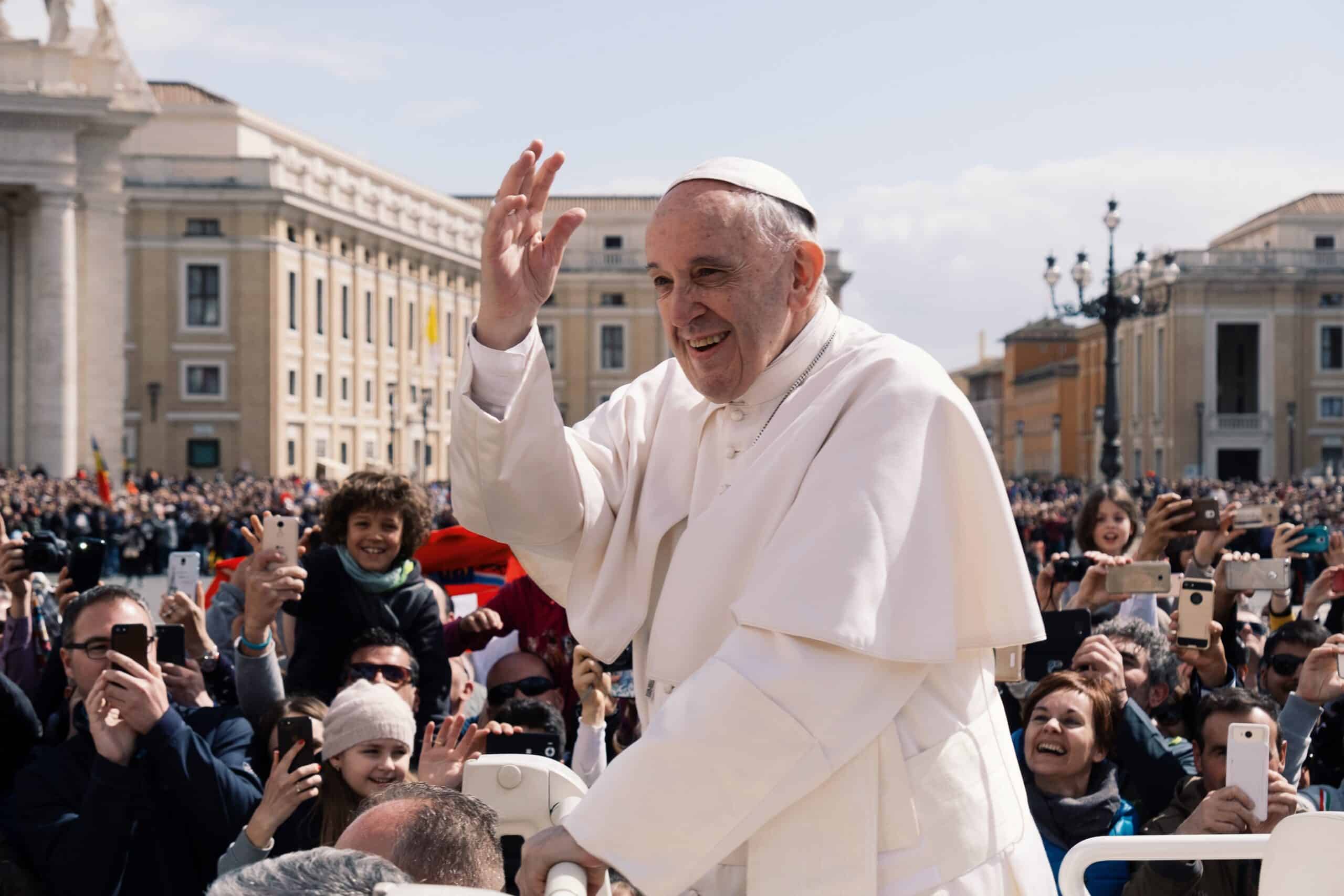Ten years ago this Saturday, Pope Francis spoke these five simple words that reverberated around the world: “Who am I to judge?”. Then a relatively new pontiff, this was his comment in response to a reporter who inquired about a “gay lobby” in the Vatican. Francis went on to add that LGBTQ+ individuals “shouldn’t be marginalized. The tendency [to homosexuality] is not the problem…they’re our brothers.”
Given the West’s dramatic increase in acceptance of LGBTQ+ individuals, revisiting the last ten years can ensure that the impact of these simple words is not lost to time. According to Gallup, Americans’ view of the moral permissibility of gay and lesbian relationships increased from 55% to 71% from 2012 to 2022. Moreover, Obergefell v. Hodges, granting the legal right for all Americans to civil same-sex marriages, would not be decided until 2015. The recent controversies over special Masses for Pride Month were non-issues because it was unfathomable for any parish to celebrate Pride. Lastly, Pope Benedict had written in his 2010 book Light of the World: The Pope, The Church and the Signs Of The Times that “homosexuality is incompatible with the priestly vocation.”
Having contextualized the world of 2013, it is less surprising how these five words featured prominently in the press’s coverage of the new pope. Time Magazine, which named Jorge Bergoglio as the “People’s Pope”, cites this famous question in its promulgation of Pope Francis as their 2013 Person of the Year. Some press outlets suggested that Pope Francis might even change official church teaching on homosexuality. Meanwhile, other media organizations were quick to parse Francis’ statement to demonstrate that he had no intention of changing church teaching.
What is the significance of these words ten years later? Indeed, the debate is still ongoing as to what degree LGBTQ+ individuals can participate in the life, activities, and sacraments of the Church. A brief review of the last ten years of Francis’ pontificate will reveal how the Catholic Church’s relationship with queer Catholics has evolved.
Certainly, Pope Francis through various statements and actions has continued to invite LGBTQ+ Catholics into closer relationships with the church and broader society. Most notably, Francis in a 2020 documentary voiced support for civil same-sex unions, saying that “What we have to create is a civil union law. That way [gay people] are legally covered.” More recently, the pope instructed bishops not to support criminalization laws for homosexuality, stating that a homosexual act is “not a crime. Yes, but it’s a sin.” Just a few weeks ago, Francis sent his good wishes and prayers to the Outreach LGBTQ Catholic Ministry Conference. Earlier in his papacy, he wrote in The Name of God is Mercy that he “prefer[s] that homosexuals come to confession, that they stay close to the Lord, and that we pray all together.” Francis even dined with incarcerated gay and transgender people in 2015.
Beyond the pope, the broader church has made efforts to minister to LBGTQ+ Catholics. Following the shooting at Pulse Nightclub, Fr. James Martin, SJ wrote Building a Bridge: How the Catholic Church and the LGBT Community Can Enter into a Relationship of Respect, Compassion, and Sensitivity. Last month, the Vatican released the working draft of the ongoing synod’s document which calls for a new pastoral approach to queer Catholics, notably using the LGBTQ+ acronym which the church had long avoided.
At the same time, the church’s teaching authority has been clear in upholding traditional teachings on marriage and family life. Following Francis’ comments supporting civil same-sex unions, the Congregation for the Doctrine of the Faith (now a dicastery) clarified that church doctrine has not changed. Some months later, the Vatican further stipulated that the church cannot bless same-sex unions.
The response of the dicastery relies on Francis’ apostolic exhortation Amoris Laetitia saying that “there are absolutely no grounds for considering homosexual unions to be in any way similar or even remotely analogous to God’s plan for marriage and family.” In turn, God’s plan for the family is succinctly summarized in the Catechism of the Catholic Church 1601: “The matrimonial covenant, by which a man and a woman establish between themselves a partnership of the whole of life, is by its nature ordered toward the good of the spouses and the procreation and education of offspring.”
With this seesaw of comments and responses, it can be difficult to assess whether anything has changed. While nothing may have officially changed in the church’s doctrine or practice, one thing is irrefutable: the tone of the Vatican has shifted. To the handful of LGBTQ+ Catholics I know, this development has meant everything. And this sudden change in tone is why “Who am I to judge” stands out so prominently in the memories of my queer friends of faith.
The story of my friend, whom I’ll refer to as ‘Mark’ to maintain anonymity, exemplifies just how consequential the new official tone has been for a gay Catholic. I recently chatted with Mark to hear his reflections now that “who am I to judge” is a decade past. To him, the pope’s five simple words ten years ago were a “game-changer” for his understanding of his place in the Catholic Church.
Mark grew up in a devout Catholic family. He can remember subtle messages from his culture, and even explicit messages from the institutional church, suggesting that a non-heterosexual orientation is something to be locked away. As Mark started to understand that he might be gay, he felt he had to leave that part of him in the parking lot on Sundays.
As he started to develop a closer relationship with God through various retreats, Mark started to hear a call to the priesthood. These dreams for his future were quickly dashed by Benedict’s comments on the priesthood and homosexuality. In his words, Mark felt he needed to “bolt that door close.” While he did not blame or abandon God, he was left trying to piece together a new future for himself that he felt neither he nor God wanted for him.
Mark accepted his sexuality some years later, leading him to work to reconcile his faith with this aspect of his identity. He recalls a significant conversation with a priest when he disclosed his orientation. The priest asked Mark what he desires his relationship with the church to look like. My friend articulated for the first time that he wants to be his whole self and be Catholic. He wanted to be “inside the church, not outside it.” Still, Mark was not sure if that was possible given the doctrinal language of “intrinsically disordered” that often accompanied any statement from the church on LGBTQ+ matters.
Then, Pope Francis said those five words. The sense of warmth and welcome from the Pope made him finally believe that maybe the Catholic Church wanted him inside too. The catechism’s language and the Church’s comments on homesexuality and the priesthood did not torment him as much as they had in the past. He even considered exploring a priestly vocation again. Mark was not surprised that the pope did not change any church teaching. The most important thing was that he felt his home had finally embraced him.
Mark remembers how different it felt walking into his parish in the following months. No longer did he need to leave a part of himself at the door. Mark told me, “I always wanted to bring my entire self to the Lord so that he could guide me on the path to holiness. At last, I sensed that I could offer my entire being to our God.”
Now that he sensed that he could live his universal call to holiness, Mark became more attuned to the needs of others and how he might help people recognize God’s great love for them. One of the ways he did this was by teaching confirmation and volunteering for the parish youth group. Mark cherishes these years of accompanying young people as they started to understand how religious faith is relevant to their lives. In one particular instance, he recalls a high school girl being distressed as she came to recognize she might be queer. While Mark did not disclose his own orientation to her, he encouraged her and assured her of the gifts she still has to offer the church and the world. That simple affirmation helped her maintain hope that God still desires her to be in the church.
Mark reflects that if Pope Francis had not given him permission to accept himself, he could not have counseled the young girl. Mark likens his ministry before Pope Francis’ comment to that of Jesus’ image of a blind person leading another (cf. Luke 6:39). Pope Francis’s words gave Mark a new vision of his life, and now he can help others see more clearly God’s hopes for them.
As my conversation with Mark came to a close, I asked him what─if anything─he seeks from the church a decade later. Mark returned to the moment years ago when the priest asked him what he wanted his relationship with the Church to look like. Now, he asks that “the church do the same: ask itself what it wants its relationship with the LGBTQ+ community to be.”
I find Mark’s reflections particularly salient for this moment in history. Americans’ acceptance of LGBTQ+ individuals dropped by seven percentage points last year. Catholics are increasingly divided about whether or not they can celebrate Pride Month. Nonetheless, the church is taking up this precise question (among many others) in the global synod.
Still, one lesson is clear. Many LGBTQ+ Catholics, like Mark, feel more welcome in the church. Some queer Catholics and their allies are not satisfied with only a change in tone. Nevertheless, as Mark’s own story demonstrates, many of our gay brothers and sisters want to be inside the church. Ten years ago, Pope Francis opened wider the door.
Photo by Ashwin Vaswani.
Editor’s Note: The interviewee has requested to remain anonymous. The author received explicit permission to share Mark’s story. To protect the identity of the interviewee, the author changed his name and generalized details about his life.


